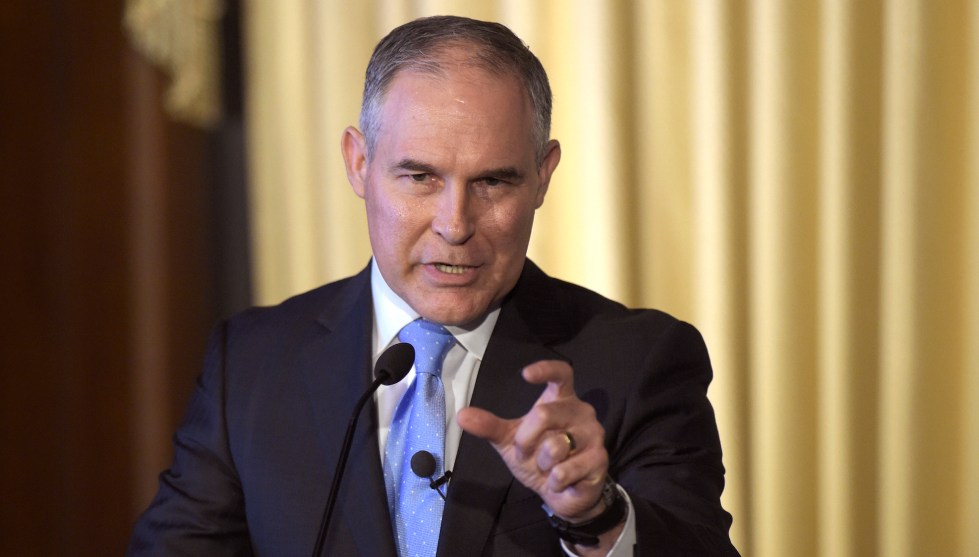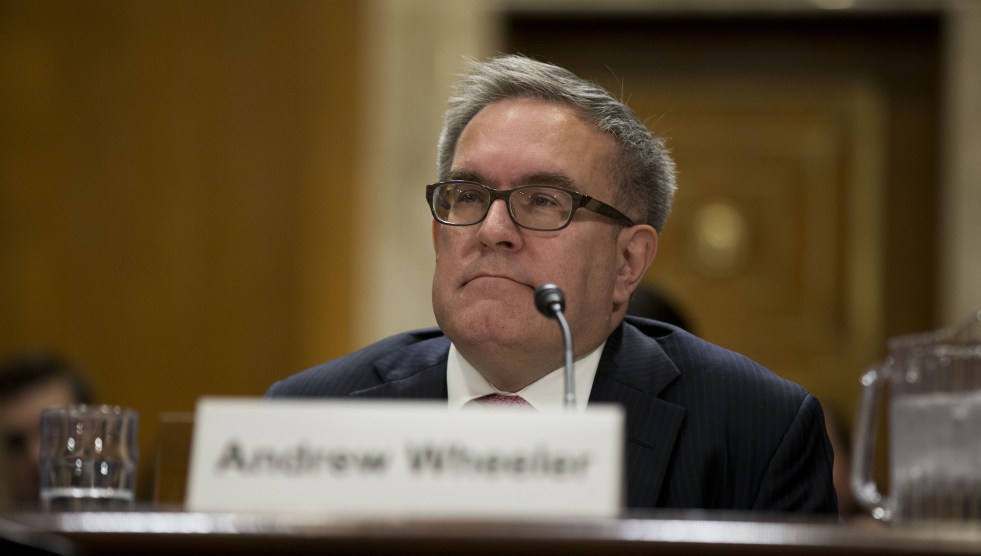
Mother Jones illustration; georgeclerk/Getty
For years, the Environmental Protection Agency’s regulation of radiation, carcinogens, and other toxic chemicals has been based on the cautious scientific reasoning that considers even slight exposure to toxins potentially risky to public health. From that premise, the EPA has assessed a wide range of pollution, including lung-clogging particulate matter, Superfund cleanup, water treatment, radiation exposure, and risk assessments for carcinogens like benzene.
That time-honored approach may be changing because of easy-to-overlook phrasing within a paragraph buried in the proposed “Strengthening Transparency In Regulatory Science Rule,” a regulation that will bar the EPA from considering a wide range of scientific studies in its rule-making. With a few sentences buried in the seven-page Federal Register text, the EPA is opening the door to a new scientific approach that—in a worst-case scenario—could further relax regulations because of the assumption that a little pollution is actually beneficial.
Some scientists have considered the implications of this paragraph and described a whole array of potential problems to Mother Jones. Because the paragraph is written in incredibly vague language, most scientists were unable to explain which pollutants or regulations were the prime targets. Moreover, the various examples of pollutants that it could affect were not based on the prevailing scientific literature.
“I was surprised to see it,” said Jonathan Levy, an expert in human health risks from the environment at Boston University who was one of the scientists warning of the implications from this passage. “The EPA looks at dozens upon dozens of toxins, and there are decisions based on exposure above and below a certain level, and cancer-risk above and below a certain level. This could be so sweeping to affect almost any chemical under consideration.”
Despite its potential importance, this change has attracted little attention. One likely reason is that with phrases citing the “growing empirical evidence of non-linearity in the concentration-response function,” the language is impenetrable for all but the most serious specialists. But the change has been noticed and celebrated by the chemicals industry, as well as EPA critics in conservative circles who have previously challenged the agency on everything from its acceptance of climate change science to the health costs of air pollution.
On Wednesday afternoon, a congressional hearing on the proposed rule will be held by a Senate Environment and Public Works subcommittee. One of the witnesses will be an enthusiastic proponent of the change, University of Massachusetts environmental health scientist Edward Calabrese, who discloses that one of the funders for his research into toxicology is ExxonMobil. Calabrese has long argued that the science supports the argument that low levels of exposure to cancer-causing substances are actually beneficial—which is tantamount to saying that a little bit of it is good for you.
So, how could this have happened?
It all began with Scott Pruitt. A few months before his many controversies finally cost him his job, the EPA Administrator proposed a far-reaching rule that would have drastically limited the kinds of scientific studies that the EPA considers legitimate.
The response to the “Strengthening Transparency In Regulatory Science Rule” was immediate and overwhelmingly critical. During the three-month public comment period, which ended in August, scientists, environmentalists, and public health groups warned that the effect of this single political act would mean the EPA would ignore or dismiss the best available science in order to tilt its regulatory work in industry’s favor; they’ve taken to calling the rule a “censored science proposal.”
By requiring data to be made public, which researchers say is impossible when it comes to decades-old landmark studies based on sensitive medical records, the rule would effectively slash the body of research that underpins the EPA’s work. The primary target of the rule is the landmark air pollution studies that look at the health effects of fine particulate matter on the lungs, but it can touch virtually any rule relying on sensitive medical records, from lead poisoning to mercury.
In order to understand how this change could potentially unleash dangerous toxins into the public sphere, it’s important to understand how standards have been set historically. The model has long held that there is a direct relationship between the dose and the level of harm, which is known as the “linear no-threshold” (or LNT) risk-averse version. This model acknowledged there are still risks associated even with the lowest levels of exposure. Some people—babies, children, the sick and elderly—are more vulnerable than others, so there is no single threshold that can be considered safe.
No one is spared exposure to a mass of potentially dangerous substances such as lead, mercury, asbestos, formaldehyde, and fine particulate matter. A growing body of epidemiological evidence shows how even the tiniest exposure of some of these substances for fetuses and children can have profound effects on their development. Radiation, too, may be everywhere, but the risks rise with higher exposure, such as near a Superfund cleanup site or for workers at a nuclear plant. The consensus model adopts a risk-averse approach, suggesting a linear relationship between risk and exposure.
A small community of scientists and interests, some funded by the chemical and fossil fuel industries, has argued for years that the EPA should replace its existing standards with more flexible ones. Instead of the “linear no-threshold” risk-averse version, some would prefer one that could raise the threshold at which the EPA considers exposure dangerous.
In fact, they argue, there are benefits to low doses of radiation, lead, and other toxic exposures. The Cato Institute’s Patrick Michaels, an EPA critic and climate skeptic, cheered the departure from LNT as a paradigm change in a blog post: “The LNT model isn’t just wrong—nature actually works opposite to it. Small amounts of exposure to things that are toxic in large amounts can actually be beneficial.”
That line of reasoning also appeared in the EPA press release when Pruitt announced the regulation, giving a hint of what was really buried in the rule. Among the supporters, which included a handful of Republican politicians, were three scientists who lent their scientific weight supporting the new rule.
One of them was Edward Calabrese, who wrote in his statement for the EPA in April, “The proposal represents a major scientific step forward by recognizing the widespread occurrence of non-linear dose responses in toxicology and epidemiology for chemicals and radiation, and the need to incorporate such data in the risk assessment process.” His endorsement was surprising for many reasons, not the least of which was because the word “radiation” does not appear anywhere in the rule.
Calabrese is one of the leading scientists who advocate moving towards a model known as hormesis. Proponents argue hormesis is preferable to the LNT model because some exposure is actually good for public health—a little bit of the toxin inoculates you from its greater dangers. “The question is how does the EPA find a way out of this regulatory quagmire of using the historically corrupt and scientifically flawed LNT model?” he wrote. “The EPA proposal should be accepted and implemented across all programs involving risk assessment as soon as possible.”
Levy responded to Calabrese’s argument that the EPA’s best course of action is to find a “regulatory sweet spot” that combined various models, some of which assume that some exposure is actually good for you. It could make a major difference for the most vulnerable if the EPA operates under the assumption that very low doses could be good for you instead that they can be harmful. “He is basically saying that the risk levels considered by EPA to be unacceptable are fine,” Levy says, “because it would be hard to detect the effects.”
Calabrese declined several requests to be interviewed, pointing instead to his work, “which speaks for itself.”
Steve Milloy, who has made a career out of contesting the science around tobacco’s health effects, also supports the new rule. He has a long record of denying climate change and the dangers of air pollution and blogs on personal website JunkScience. A few days after the announcement, Milloy wrote a brief obituary for the “linear no-threshold” model: “The LNT model was born in fraud, caused great harm, during its lifetime and will die in ignominy. We will bury it via the opportunity provided by the Trump EPA science transparency initiative.”
The EPA is now claiming—without supplying the evidence—that there is a growing scientific consensus that supports loosening the agency’s longstanding approach in which even low levels of exposure to cancer-causing chemicals and radiation are considered to be harmful. All this flies in the face of 40 years of scientific study that has explored the uncertainty surrounding these models. The National Academy of Sciences, the National Regulatory Commission, and the EPA’s independent science advisory board have looked in recent years at whether the LNT default model is still the best approach. (The EPA has contested the Associated Press‘s reporting on this approach to loosening its radiation rules; you can read its reply here.)
The EPA, in fact, strongly came out against the last time a regulatory body attempted to review its LNT model. The NRC in 2015 looked at the debate in 2015 when it considered reviewing its radiation standards, and the EPA wrote at the time: “Over the last half century, numerous authoritative national and international bodies have convened committees of experts to examine the issue of LNT as a tool for radiation regulation and risk assessment. Again and again, these bodies have endorsed LNT as a reasonable approach to regulating exposures to low dose radiation.”
Now, environmental groups like the Natural Resources Defense Council and independent scientists charge that even without the proof of empirical evidence, the EPA is likely to adopt the kind of models favored by Milloy and Calabrese. Politics has trumped careful scientific review.
John Bachmann, who retired from the EPA office of air and toxics, stressed the implications for the overall costs and benefits for the agency’s rules, which tabulate the lives saved in dollar-value from reducing fine particulate matter. “It has really broad implications for setting regulations for carcinogens or lawsuits to roll them back,” Bachmann says. “It has implications for doing cost-benefit analysis of all pollutants, even [particulate matter] pollutants, the biggest driver of all pollutants.”
Once the scientific assessments are undermined, so too are the policies that are supposed to protect people. “This is a situation analogous to having global warming deniers in charge at the EPA,” said Jan Beyea, a nuclear physicist with Consulting in the Public Interest. He compared it to the tiny world of scientists who charge that climate change is exaggerated, propped up by the same industries that benefit from muddying the waters in the public’s eye.
The rule is the most recent example of the Trump administration undermining science. It has already reorganized the EPA’s independent science advisory boards and disbanded the position of the EPA chief science adviser. “The only thing left standing at the end of this scorched-earth anti-science series of policies,” NRDC’s senior scientist Jennifer Sass says, “would be the industry-sponsored studies, because they adhere to these guidelines for the purpose of getting regulatory approval.”
It is unclear how the language in the EPA rule may be implemented, or if the EPA’s acting administrator Andrew Wheeler intends to follow through with a plan that was first put in motion by Pruitt. But if it is implemented, it could potentially leave children, elderly, and the ill—typically the most vulnerable to environmental pollution—more vulnerable to the effects of increasing toxins. A family living near a cleaned-up Superfund site could be faced with potentially higher levels of radiation and toxins, while consuming treated water from a nuclear plant containing higher levels of radiation, or breathing in more fine particulate matter that’s now considered less harmful.
Meanwhile the government would justify its policies by claiming that science considers this exposure could benefit public health. By changing the underlying science, the EPA would make it easier to justify deregulation in the courts. The best option, Beyea notes, would be for the EPA to “look at this in an objective way, and not do it based on a small minority theory” that happens to support the industry position for less regulation.
What’s ultimately at stake, Beyea told Mother Jones, is the “levels which the population will be exposed to in the future of various chemicals, whether they be pesticides or radiation in certain cases of relief and accident, like a Fukushima. At what level do you start to run away from the plant, at what level do you start to relocate? These are difficult questions. There’s no easy answer for them.”
















